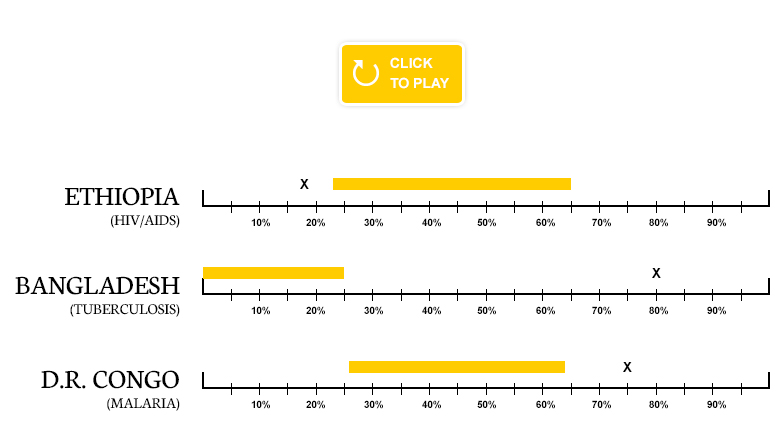Contracts between global health donors and their partners may seem mundane and detached from the life-saving activities that prevent and treat AIDS, TB and malaria. But contracts lay the foundation for every bed net delivered, every TB case diagnosed, and every dose of antiretrovirals given to a person living with AIDS. A poorly designed contract can limit the number of lives saved, just as a well-designed contract can maximize the number of lives saved.
Why pay more? Conditioning money on progress creates incentives for genuine improvements in health.
A well-designed contract ensures efficiency, holds recipients accountable for results, and provides funding predictably. One contracting tool that can help achieve all three objectives is performance-based financing (PBF).
Performance-based financing connects a portion of funding to improvements in health-care coverage or health outcomes. In other words, recipients get paid when they achieve an agreed-upon health goal. This arrangement provides further incentive for recipients to make their programs as effective as possible, and assures donor investments contribute to genuine improvements in health.
The Global Fund’s Performance-Based System
Since its creation in 2003, the Global Fund has included a performance-based rating system in its grant agreements to assess how well a grantee has performed in the first phase of a grant’s lifecycle and determine an “indicative funding range” for phase 2. It’s a start, but the system is complex and falls short of its potential to clearly link at least a portion of funding directly to performance, largely for two reasons.
First, the Global Fund’s current rating process relies not on outcomes but on input and output indicators (such as bed nets purchased and distributed) and a number of other contextual factors (such as financial management) that may be important for grant management but do not gauge if a program has actually improved health.
Second, the Global Fund’s performance ratings do not directly correspond to subsequent funding levels. An analysis of its grants found little statistical relationship between performance ratings in phase 1 and funding levels in phase 2. Figure 1 illustrates these discrepancies.
Figure 1. Grant Performance Does Not Predict Disbursement Levels

The Global Fund recognizes that performance should factor into how funding is allocated, but without linking a portion of funding directly to performance—and performance alone—it orients recipients to focus on measuring inputs and outputs instead of results. Worse, it weakens recipients’ ability to assess their progress against meaningful indicators and predict their prospects for future funding. Only 34 percent of Global Fund grant recipients reported in a 2013 Aidspan survey that “the grant rating system accurately reflects performance.” If recipients do not feel that their performance is accurately measured or tied to funding, performance-based financing will not motivate them to do better.
In Africa, performance based financing is increasing the quality and use of key health services.Monique Vledder, Sr Health Specialist & Program manager, Health Results Innovation Trust Fund, The World Bank
Making Performance-Based Financing Work
Performance-based financing works best when payments and performance are linked clearly and directly, and when performance is measured in a simple, objective way. To that end, the Global Find could take several steps to improve its approach and reinstate its position as a leader and innovator in performance-based financing. A one-size-fits-all approach is not possible given the many countries and constituencies with which the Global Fund works, but the Fund should pilot and rigorously evaluate the steps below to identify the best approach for different contexts.
Choose Fewer, but Stronger, Key Indicators
The Global Fund should drastically reduce the number of performance indicators by excluding input and output indicators and instead focus on key health-care coverage and outcome indicators. The Global Fund can work with countries during grant negotiations to identify which core indicators work best for them and determine which will be directly linked to payments. For instance, a country that has malaria under control but nonetheless needs budgetary and programmatic support to keep it at bay may find an indicator that measures lasting achievements in disease control and prevention most useful.
Directly Connect a Portion of Funding to Incremental Progress on Key Indicators
The Global Fund should set aside a dedicated tranche of funding that would be directly linked to progress on one or more core indicators. Payments would be made against incremental progress toward high-quality service coverage or health outcomes, such as $30 for each additional person initiated and retained on ART. Because tying all program support directly to performance is neither feasible nor desirable, this tranche could be provided on top of a guaranteed “base” level of funding provided to ensure continuity of care. The basic structure necessary for this approach is already in place in the New Funding Model, where the Global Fund has set aside “incentive funding” for each country to reward “ambitious” proposals. The Global Fund should go a step further and deploy this incentive funding to reward ambitious and successful programs that achieve progress on health goals.
Only one-out-of-three Global Fund recipients believe that the grant rating system accurately reflects performance.
Continue Multidonor Coordination to Support Performance-Based Financing
Fledgling coordination between the Global Fund and other donors on existing performance-based financing platforms is promising and should be continued. A lot of programs overlap: the World Bank’s PBF-focused Health Results Innovation Trust Fund (HRITF), for instance, also operates in four of the Global Fund’s “high impact” countries (the Democratic Republic of the Congo, Nigeria, Zambia, and Zimbabwe). Where appropriate, the Global Fund should encourage these countries to include collaboration with HRITF in their grant applications and support joint funding or other shared arrangements between the recipients and partner organizations.

Tools